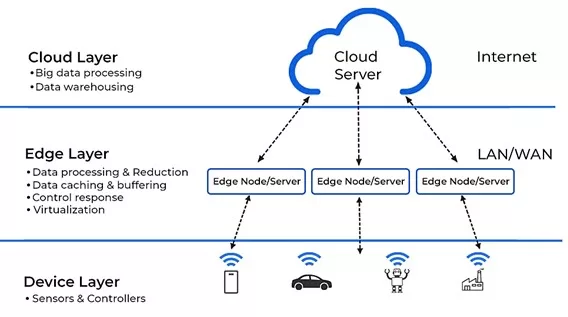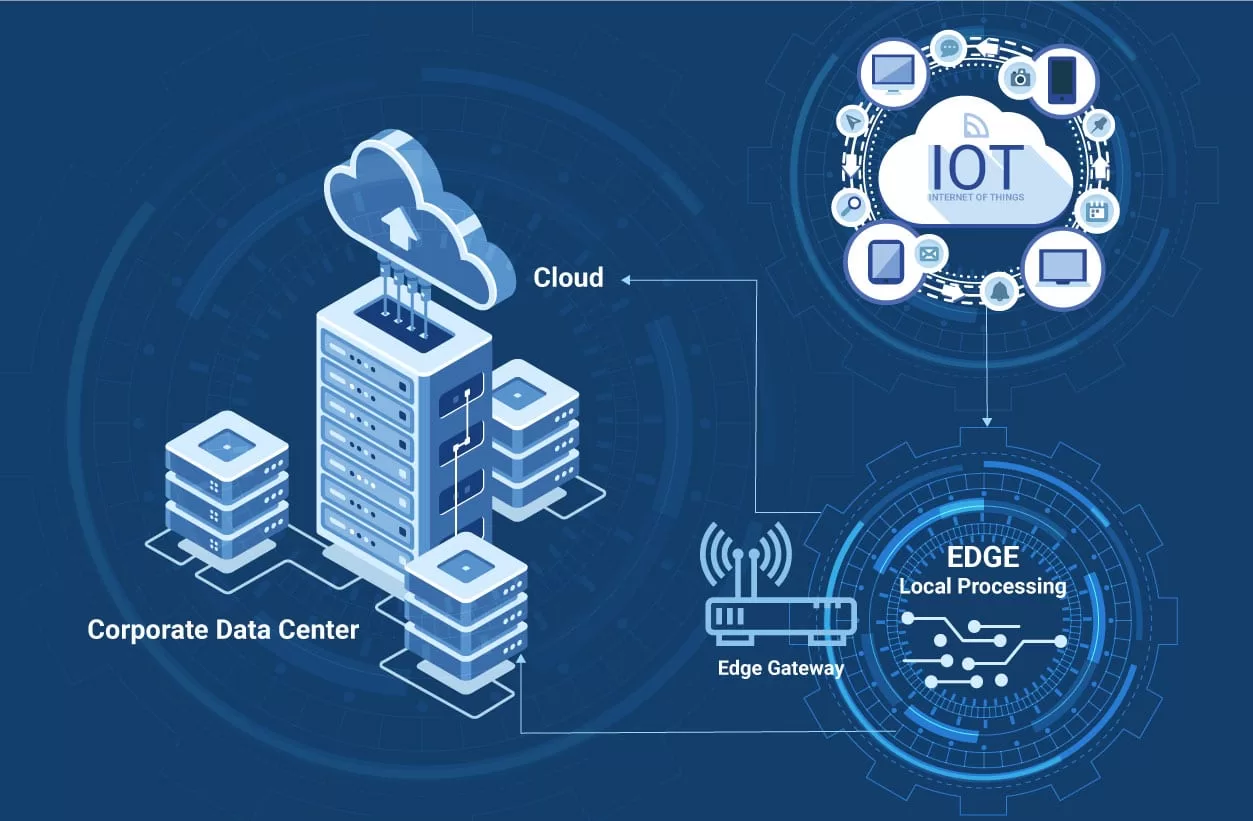Abstract
The insights from 3GPP Release 17 have introduced pivotal features that enhance and enable Edge Computing within the IoT ecosystem. These features aim to optimize data processing, reduce latency, and seamlessly integrate Edge Computing capabilities.
The marriage of Edge Computing and IoT is not a mere technological trend but a strategic imperative. The relentless growth of IoT devices, coupled with the increasing need for real-time insights, has underscored the limitations of conventional cloud-based architectures. As IoT applications become more sophisticated and diverse, the demand for low-latency, high-throughput data processing becomes paramount.
These features collectively empower real-time data processing and efficient communication, supporting businesses in harnessing Edge Computing’s transformative potential.
What is Edge Computing?
Edge computing refers to a decentralized computing approach where data processing and analysis occur closer to the data source, often at the “edge” of the network, rather than in a centralized cloud environment. This concept aims to address the limitations of traditional cloud computing, such as latency issues and excessive data transmission to remote data centers. By processing data locally, edge computing enhances real-time responsiveness, reduces latency, optimizes bandwidth usage, and enhances overall system efficiency.
The Internet of Things (IoT) plays a crucial role in unlocking the true potential of edge computing. IoT refers to the interconnected network of devices, sensors, and objects that collect, exchange, and transmit data. The convergence of IoT and edge computing creates a powerful synergy that revolutionizes data processing and analysis in various industries.
Insights from 3GPP Release 17
The 3GPP Release 17 introduces several key features that enable and enhance Edge Computing within the IoT ecosystem. These features are designed to optimize data processing, improve latency, and facilitate seamless integration of Edge Computing capabilities. Some of the exact features from Release 17 that enable Edge Computing include:
- Ultra-Reliable Low Latency Communication (URLLC) focuses on further reducing communication latency and enhancing reliability. This is crucial for Edge Computing, where real-time data processing and decision-making are essential. URLLC enables applications that demand ultra-low latency, such as industrial automation and real-time control systems.
- Integrated Access and Backhaul (IAB) allows for dynamic deployment of wireless backhaul connections, enabling flexible and efficient connectivity for edge devices. This feature enhances the connectivity infrastructure for Edge Computing deployments in various scenarios.
- Device to Device (D2D) Communication Enhancements facilitate direct communication between IoT devices without the need to route through a centralized server. This enables quicker data exchange and decision-making at the edge, reducing reliance on distant data centers.
- Network Slicing for Edge Computing allowing operators to allocate specific portions of the network for Edge Computing purposes. This enables dedicated resources for edge applications, optimizing performance and responsiveness.
- Multi-Connectivity Enhancements: enable devices to simultaneously connect to multiple networks or cells. This enhances reliability and robustness, crucial for applications that require continuous connectivity for real-time data processing at the edge.
- Mobility Enhancements enable seamless handover of connections between different access points, ensuring uninterrupted data processing for edge applications, even when devices are on the move.
- Local Area Data Networks enabling efficient data exchange and communication within a localized environment. This is particularly useful for Edge Computing deployments in confined spaces or localized scenarios.
These features collectively enhance the capabilities of Edge Computing in IoT, enabling real-time data processing, reduced latency, and efficient communication between devices and edge nodes. This empowers businesses and industries to leverage Edge Computing’s transformative potential for improved operational efficiency and enhanced user experiences.
IoT Edge Computing Benefits and Use cases
One of the hallmark benefits of integrating edge computing into the IoT ecosystem is its transformative effect on data flow dynamics. Traditional IoT architectures often involve the constant transmission of raw data to centralized servers for processing. However, with the advent of edge computing, this paradigm shifts towards localized data processing and real-time insights.
- Reduced Latency: Edge computing drastically reduces the latency inherent in traditional IoT setups. By processing data at the edge, near the data source, organizations can achieve real-time decision-making. This is especially critical for time-sensitive applications such as autonomous vehicles, industrial automation, and healthcare monitoring.
- Bandwidth Optimization: The centralized approach leads to substantial network congestion and bandwidth consumption, especially as the IoT network scales. Edge computing alleviates this burden by filtering and processing data locally. Only pertinent insights are transmitted to the cloud, minimizing bandwidth usage and enhancing network efficiency.
- Local Data Processing: Unlike their predecessors, modern IoT devices possess computational capabilities that enable local data processing. This enables devices to execute complex algorithms and logic without relying on continuous cloud connectivity. Examples include real-time image recognition, natural language processing, and predictive maintenance.
- Real-time Anomaly Detection: The fusion of edge computing and IoT equips devices with the ability to detect anomalies in real time. By analyzing data at the edge, devices can swiftly identify deviations from normal patterns and trigger immediate responses. This feature finds applications in security systems, industrial quality control, and predictive maintenance.
- Predictive Maintenance: Edge-enabled IoT transforms manufacturing by predicting machine failures and prompting maintenance actions, reducing downtime and enhancing efficiency. Real-time quality control and supply chain optimization further improve production standards and visibility.
- Telemedicine Advancements: Edge-enabled IoT revolutionizes healthcare by enabling remote patient monitoring, timely diagnoses, and personalized treatments. Additionally, edge computing enhances emergency response systems, providing rapid data analysis and improving disaster relief efforts.
Architectural Foundations of Edge Computing and IoT Integration
IoT devices generate vast data and demand millisecond-level processing. Currently, around 10% of enterprise data is handled outside traditional data centers or the cloud, a figure projected to reach 75% by 2025. IDC notes similar trends, foreseeing the global datasphere to reach 175 zettabytes by 2025.
An optimized edge IoT network manages data influx and some processing. Yet, tasks like rapidly unlocking a security door can’t afford round-trip delays to the cloud. Certain edge devices, due to limited computing power, can’t analyze data collected, while others generate excessive raw data. This diversity has led to various approaches in Edge Computing Architecture.
- Pure Edge Architecture: Embracing local processing, housing all resources on-site. Ideal for data sovereignty and security, yet demands significant initial investment.
- Thick Edge + Cloud: Balancing local and cloud resources, capitalizing on scalability and existing infrastructure for flexibility and control.
- Thin Edge + Cloud: Agile, direct edge-to-cloud linkage for cost-effectiveness, but raises data privacy, latency, and security concerns.
At a basic level, edge IoT architecture will consist of 3 layers: The Cloud Layer, the Edge layer and the Device server.
Cloud Layer
The Cloud Layer serves as a versatile entity, encompassing both public and private cloud environments. Within this layer, container-based workloads, including applications and machine learning models, find a repository. These clouds are also home to the applications responsible for orchestrating and managing distinct edge nodes. Bidirectional interaction occurs between workloads at the edge – encompassing local and device-oriented tasks – and those residing within these clouds. Furthermore, the cloud functions as a source and destination for data required by other nodes, accentuating its pivotal role.
Conversely, the edge servers hold the responsibility of transmitting a portion, or even critical datasets, to the cloud layer for storage and in-depth analysis. This interaction underscores the seamless integration that transpires between the cloud and edge layers.
Edge layer
Sited between the Cloud and Device Server, this stratum predominantly encompasses edge servers. Thus, facilitated by distributed edge computing, the edge layer becomes adept at handling data in proximity to its source. This localization stands as a potent remedy for latency, significantly heightening real-time responsiveness – a boon for time-critical applications. Within the Edge Layer, reside edge devices endowed with computational prowess, driving preliminary data processing, filtration, and rudimentary analytics.
Data that exceeds the scope of edge layer processing finds its recourse in the cloud layer, ensuring the integrity of information. By orchestrating data processing at this intermediary tier, organizations can expediently extract pivotal insights while concurrently curbing network congestion and mitigating the need for extensive data transmission to the Cloud Layer.
Device layer
At the bedrock of the architecture lies the realm where IoT devices seamlessly interface with the wider system. While convention often confines them to mere physical entities, any entity collecting and transmitting data can aptly function as a sensor – encompassing parameters like light, temperature, moisture, GPS coordinates, and vehicular onboard diagnostic data.
Within the IoT context, the mental image typically conjured involves hardware devices bedecked with sensors, primed to initiate and regulate actions while transmitting IoT data. Instances encompass microcontrollers nestled within smart vehicles and home appliances, alongside single-board computers exemplified by Raspberry Pi units seamlessly integrated into robotics and industrial machinery.
Enter actuators, pivotal in steering or responding within the IoT framework. These agents, whether manifested in hardware or software, effectuate transformations within a product or its surroundings. APIs hold the reins in triggering actuators, guided by insights gleaned from the broader IoT architecture. The spectrum of actuators spans the gamut from smart lighting and remote-controlled access points to motors, robotics, and software directives.
This stratum undertakes the role of data aggregation, preliminary preprocessing, and initial sieving before relaying the gleaned intelligence to the Edge Layer for more intricate processing. Its operational efficiency and nimbleness are pivotal in nurturing real-time applications and expediting well-timed decision-making processes.

Figure 1: IoT Edge Computing Basic Architecture
Future Prospects and Emerging Trends
As the integration of edge computing and IoT continues to evolve, the trajectory of edge computing and IoT convergence points toward a future rich with possibilities.
The continuous evolution of 3GPP standards fuels the progress of edge-enabled IoT. Here, we delve into the potential directions for further advancements:
- Distributed Intelligence: The fusion of edge computing and IoT could lead to distributed intelligence, where devices collaborate to process data and make decisions. This paradigm shift could bring about more autonomous and context-aware IoT systems.
- Federated Learning: Edge devices can collaborate to train machine learning models locally through federated learning. This enables collective learning without centralizing data, addressing privacy concerns while advancing AI capabilities.
- Edge-as-a-Service (EaaS): Just as cloud services revolutionized computing, EaaS could bring computational power closer to end-users. This concept envisions edge devices providing on-demand processing and storage resources, fostering a decentralized computing ecosystem.
- AI at the Edge: Research collaborations can explore innovative AI algorithms tailored for edge devices, enabling sophisticated data analysis and decision-making capabilities without relying heavily on cloud resources.
- Cross-Domain Integration: Collaborative efforts could drive integration between edge-enabled IoT and other emerging technologies, such as 5G, AI, and blockchain, unlocking novel applications and capabilities.
The future of edge-enabled IoT holds immense promise, and the realization of this potential rests on the shoulders of interdisciplinary collaboration, research, and innovation. As technology continues to advance, the synergy between edge computing and IoT will shape a connected world that is smarter, more efficient, and more responsive than ever before.
Conclusion
In the ever-evolving landscape of technology, the fusion of Edge Computing and the Internet of Things (IoT) has emerged as a transformative force. The journey from traditional centralized data processing to localized, real-time insights has paved the way for more efficient operations, enhanced user experiences, and innovative applications across industries.
The 3GPP Release 17 has played a pivotal role in propelling the capabilities of Edge Computing within the IoT ecosystem. These advancements serve as a testament to the continuous evolution of technology, enabling businesses to leverage Edge Computing’s potential for improved operational efficiency and responsiveness.
In conclusion, with each advancement, as we gaze into the future, the convergence of Edge Computing and IoT holds even more promise for businesses and industries.
References
- 5G Architecture for enabling Edge Applications 3GPP TS 23.558 version 17.3.0 Release 17
- Premsankar, M. Di Francesco and T. Taleb, “Edge Computing for the Internet of Things: A Case Study,” in IEEE Internet of Things Journal, vol. 5, no. 2, pp. 1275-1284, April 2018, doi: 10.1109/JIOT.2018.2805263.

